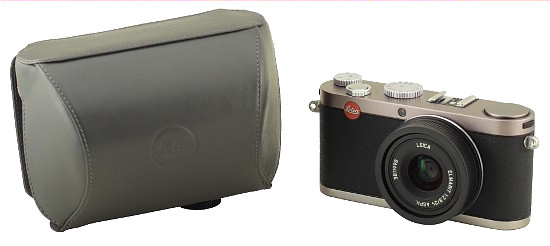Leica X1 - camera review
3. Operation
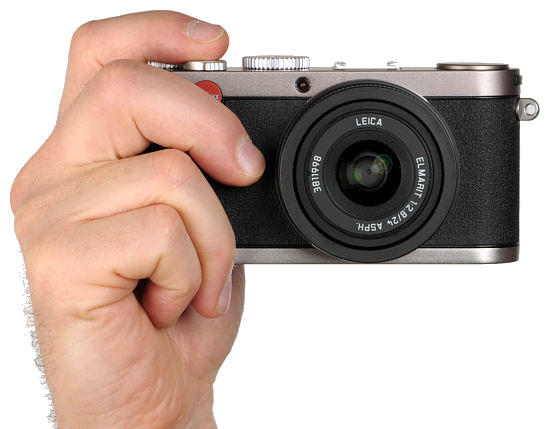
Comfort of using
As far as the comfort of using is concerned, you shouldn’t expect too much of the device of such dimensions. The camera is small and so users who have larger hands will have some problems to grab it firmly. The situation’s much better when the optional grip is mounted, making holding the camera considerably firmer. Unfortunately, Leica requires 125 $ for this small piece of plastic. We might understand it if there were any electronics and screens allowing us to change the settings of the camera. To be honest, though, much more complicated mechanically and electronically handgrips of other Japanese manufacturers often cost less…
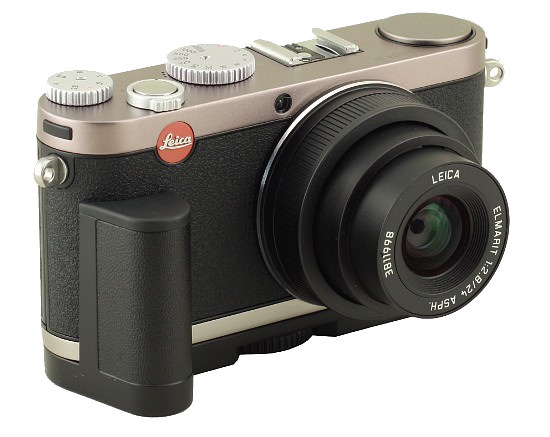
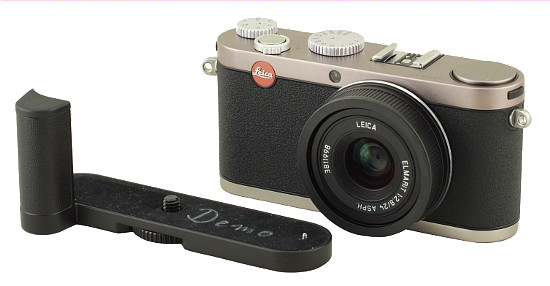
Please Support UsIf you enjoy our reviews and articles, and you want us to continue our work please, support our website by donating through PayPal. The funds are going to be used for paying our editorial team, renting servers, and equipping our testing studio; only that way we will be able to continue providing you interesting content for free. |
- - - - - - - - - - - - - - - - - - - - - - - - - - - - - - - - - - - - - - - - - - - - - - - -
We’ve complained a little, so for a change let’s praise Leica X1 a little. It’s great to operate it thanks to the shutter speed and aperture dials. When we add extra controls for changing ISO values, white balance, exposure compensation, AF mode and pop-up flash settings, we get a device that’s really easy to use. There are a few things, though, that we didn’t like. Instead of having a dedicated self-timer button I’d rather have e.g. a button responsible for choosing the quality of the picture, light metering or enabling/disabling image stabilizer. Additionally, we don’t really get it why we can change the aperture values in 1/3 EV steps and shutter speeds and ISO values in 1 EV steps. Changing the aperture via dial is done in a quirky way. In some shooting modes (in our case, when working with a self-timer) the camera didn’t instantly react to change aperture values, but kept on displaying the old one. Only after the shutter button was pressed, did the aperture actually close up, and what’s interesting, not always to the defined value. A few times it happened to us that the camera took a picture with f/3.2 even though the dial was set to f/2.8.
Speed
Speed is another thing we find some reservations with. The first impression isn’t so bad. The camera is ready to work less than a second after powering it on, despite the fact that it needs to extend the lens to a working position. Lots of cameras take up to 2-3 seconds, so Leica’s good here. We might have some trouble with saving highest-quality JPEGs, as the camera freezes for almost 2 seconds, definitely too much. It gets even worse when we take pictures in RAW/DNG and JPEG mode simultaneously, as the camera may freeze up to 2-3 seconds even if we’re using a fast memory card. What’s even worse, the manufacturers decided not to include saving single DNG files – we always need a JPEG file with it. The worst situation, though, is with displaying the pictures. Showing a picture save in DNG+JPEG takes almost 4 seconds and an ordinary JPEG as much as 3 seconds. What’s interesting, when you later zoom in the picture or pan around it, and also swap to another one, it’s done quite smoothly, but still not very fast.
Erasing all the pictures on the memory card is fast, formatting the whole memory card takes 2-3 seconds. We also didn’t find any problems with the reaction of the camera to pressing buttons and moving around the menu. Here, everything works without any unnecessary delays.
In contrast with turning the camera on, we encounter some problems when we want to turn it off. After moving the dial to Off, at first we get a classy Leica logo that we’ll have to watch for quite some time, and only after that will the lens hide and the camera turn off. The whole thing lasts as much as 4 seconds.
Continuous drive mode
We switch the camera to continuous drive mode by setting the dial responsible for turning the camera on, into the C position (there are also OFF, S and self-timer ones). In the menu we can choose between two driving modes: high and low. The manufacturer promises the speeds of 3 and 2 fps respectively, maintained to 6 first pictures taken in DNG+JPEG format. As usually, we’ve decided to test it.
The timings of continuous shooting were measured for the High mode, using the SanDisk Extreme III 8.0 GR memory card with ISO set to 1600 and the shutter speed of 1/1000 second. For particular kinds files we’ve obtained the following results during a 30-second interval:
- 26 JPEG images (0.87 fps)
- 18 JPEG+DNG images (0.6 fps)
These are, however, mean values that don’t tell much about the camera’s behavior at the beginning of the interval, which seems to be the most important case. Let’s have a look at the graphs presented below:
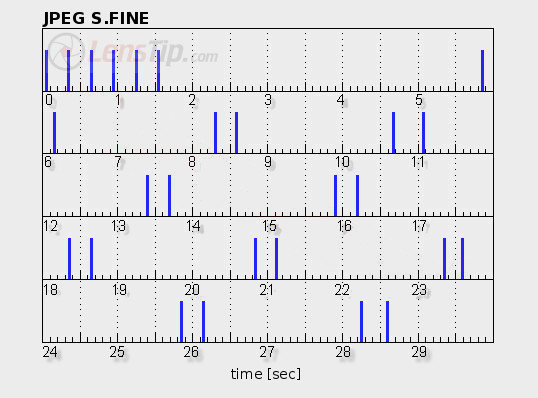
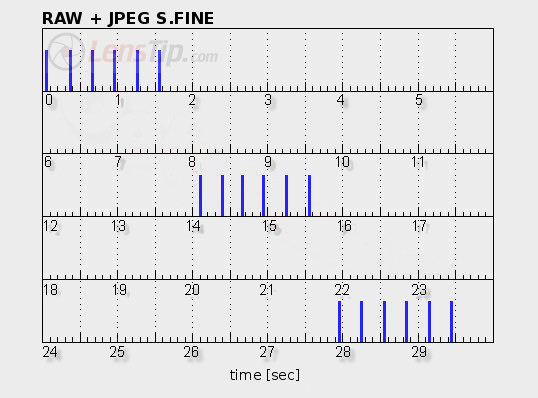
As we can see, the X1 performs quite well here. In the first second, whatever the quality we use, the camera is capable of capturing even 4 images and this speed is maintained for 6 exposures. The difference between saving JPGs alone and in combination with DNG files can be seen in the way the buffer is cleared. In the case of JPEG files the camera clears the buffer faster and captures images in pairs, in more or less 2.5 seconds interval. In the case of DNG+JPEG after capturing the first 6 images, the buffer is clearing for almost 12 seconds, after which another six-shot series is taken.
Leica X1 performs well in this aspect, much better than Sigma DP1, though still worse than Olympus E-P1, which is capable of maintaining the high speed in capturing JPEG files for the whole 30 seconds without filling up the buffer. Taking into account the fact that both cameras have 12-megapixel sensors, Leica could’ve been better here.
Menu
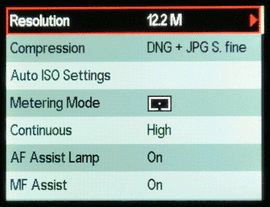 |
The menu in the X1 is very simple and consists of one big tab, in which there are the following options available:
- Resolution
- 12.2 M
- 7 M
- 3 M
- 1.8 M
- Compression
- JPG Super fine
- JPG fine
- DNG + JPG S.fine
- DNG + JPG fine
- Auto ISO Settings
- Slowest Speed (1/30, 1/15 i 1/8 sec)
- Max ISO (do wyboru ISO 400, 800, 1600, 3200)
- Metering Mode (center, center-weighted, matrix)
- Continous (High, Low)
- AF Assist Lamp (On, Off)
- MF Assist (On, Off)
- Image Stabilization (On, Off)
- Preset Film
- Standard*
- Vivid
- Natural
- B&W Natural
- B&W High Contrast
- Sharpening
- Low
- Medium Low
- Standard
- Medium High
- High
- Saturation
- Low
- Medium Low
- Standard
- Medium High
- High
- Contrast
- Low
- Medium Low
- Standard
- Medium High
- High
- Ext. Viewfinder (On, Off)
- Flash Sync (Start of Exp., End of Exposure)
- Monitor Brightness
- Low
- Medium Low
- Standard
- Medium High
- High
- Rec. Histogram (On, Off)
- Play Histogram
- Std. w/o Clipping
- Std. with Clipping
- RGB w/o Clipping
- RGB with Clipping
- Reset Image Numbering (Yes, No)
- Auto Review
- Duration (Off, 1 Second, 2 Seconds, 5 Seconds, Hold)
- Histogram (On, Off)
- Auto Power Off (2, 5, 10 Minutes)
- Auto LCD Off (30 Seconds, 1 Minute)
- Color Space (sRGB, Adobe RGB)
- Date (Setting, Sequence)
- Time (Setting, View)
- Shutter Volume (Off, Low, High)
- Acoustic signal
- Volume (Off, Low, High)
- Keyclick (On, Off)
- SD card Full (On, Off)
- Language
- English
- Deutsch
- Francais
- Italiano
- Espanol
- Japanese
- Chinese
- Korean
- Russian
- Auto Rotate Display (On, Off)
- HDMI (1080i, 720p, 480p)
- Protect
- Copy
- Format
- Firmware Version
- User Profile
- Profile 1
- Profile 2
- Profile 3
- Factory Setting
- Save User Profile
In play mode for pictures stored in the internal memory or on the memory card, there are two ways of displaying. The first one lets us see the picture with information about the aperture, shutter speed, ISO and the number of the picture displayed on the black bar below it. After pressing the INFO button we get more information. Now, we also see the resolution of the picture, its quality, the current battery status, date, time and the name and number of the picture, white balance, drive mode and the histogram.
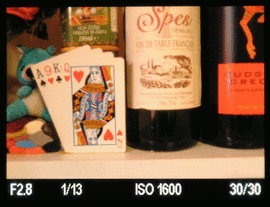 |
Pictures quality
Leica X1 lets us save picture in four modes:
- JPG Super fine
- JPG fine
- DNG + JPG Super fine
- DNG + JPG fine
It’s odd that there’s no option to save DNG files alone. We always need one JPEG file, whose quality can be set in the menu. It’s too bad, as the camera is no speed and buffer demon, so loading it with an additional JPEG file doesn’t improve the situation for sure. In the table below there are 1:1 picture clippings of our test scene, taken in full resolution, at ISO 100 and in both compression modes.
|
Super Fine 5.21 MB |

|
|
Fine 2.35 MB |

|
JPEG files themselves can be saved in four resolutions:
- 4272x2856 pix
- 3264x2160 pix
- 2144x1424 pix
- 1632x1080 pix
Built-in flash
Leica X1 has a built-in pop-up flash that is operated by a push of finger on a top of the body. It can work in the following modes:
- Auto,
- Auto + Red-Eye reduction,
- Forced On,
- Forced On + Red-Eye reduction,
- Slow Sync,
- Slow Sync + Red-Eye reduction,
- Front- or Rear-curtain Sync
- Studio.
Additionally the camera has a hot shoe on which we can mount an external flash. The manufacturer claims that Leica SF58 / SF24D are compatible with it.
Traditionally, our flash power test is conducted in a large auditorium with ISO set to 100, shutter speed of 1/100 sec. and aperture value of f/8.0. In the X1’s case we had to change the procedure slightly, as the camera doesn’t allow us to use 1/100 sec. shutter speed, so we decided to use 1/125 sec. with f/7.1 which theoretically should provide the same EV like in the standard approach. In some sense this procedure favours Leica because it gives the same EV for the ambient light, which in the test is less than the tested flash light. As we’re about to see, this hasn’t really helped Leica.
The second picture we usually take is with ISO set to 100 and leaving the rest on Auto. Leica chose the shutter time of 1/30 sec and f/2.8 aperture. The results obtained for both test combinations are presented on the thumbnails below.
| f/7.1, exp. 1/125 sec, ISO 100 | A mode (f/2.8, exp. 1/30 sec), ISO 100 |
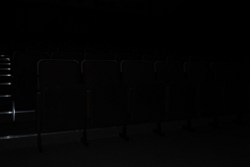
|
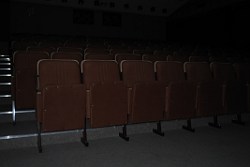
|
Unfortunately, we can’t say much good about Leica here. It’s enough to see how compact Canons G10 and G11 performed when set to 100 ISO, f/8.0 and 1/100 sec.
| Canon PowerShot G11 | Canon PowerShot G10 |
|
|
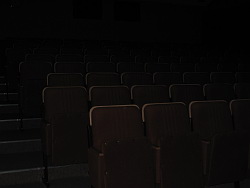
|
Image stabilization
Leica X1 offers image stabilization that can be turned on and off in the menu. By the way, it’s a pity there’s no dedicated or customizable button on the body to control it.
How efficient is the stabilization offered by Leica? We’ve decided to test it using our standard procedure, which consists of taking pictures using multiple exposure times, both with the stabilization turned on and off, and measuring the number of blurred shots. To have some good statistics material we usually take 20-40 images on every exposure time available. Usually, though, we can move by 1/3 EV steps, this time, however, we were unable to do it, as Leica allows shutter times to change by 1 EV values. In the graph below 0 EV corresponds to 1/60 sec. shutter speed.
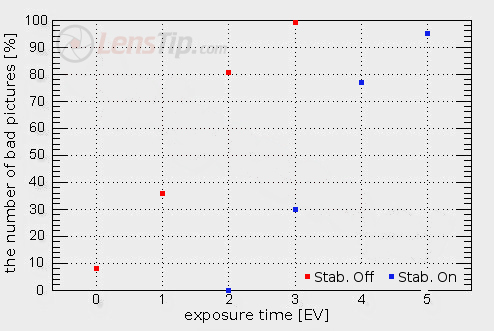
As you can see, image stabilization efficiency in the case of Leica X1 is measured to about 2.3 EV, as that’s the mean value separating the dots in the graph. It’s a good result, comparable to one seen in many DSLRs and older lenses. Thus, we have nothing to complain about here.
Autofocus
Leica’s autofocus can work in the following modes:
- 1 Point,
- 1 Point H,
- 11 Point,
- 11 Point H,
- Spot,
- Face Detection.
As for a compact camera, the autofocus is moderately fast. Going from minimum focusing distance to infinity and locking focus takes Leica about one second. Additionally, we didn’t see much difference between the modes. After going to Spot the only thing that changes is the size of the box informing about the autofocus mechanism.
As far as the accuracy is concerned, the case is quite complicated. The camera we obtained for tests seemed to have a software error (probably easy to eliminate with newer software), as from time to time, the first picture after the camera was powered on was not successful. The next one, take in exactly the same conditions, was perfect.
What’s more, in low light conditions the autofocus can be easily lost. It’s not even that it’s trying to lock, as it finds it very quickly as for the condition. Unfortunately, it misses then a lot, showing large front focus. Let me use an example from real life, here. While being in my apartment I tried to take a picture of my daughter. The only source of light in the room was the window. Outside the weather was typical for October – heavy clouds – fortunately with no rain. The X1’s autofocus kept missing set to 1 Point, 1 Point H and Spot. Only setting to Face Detection gave positive results. My daughter’s face was detected and focus set on it.
In good light conditions autofocus isn’t troublesome. And again, you can’t see much difference between the particular modes. We can, however, see how it looks like when we set focus on our test charts. Thus, we took 50 exposures at f/2.8 for the central point in 1 Point, 1 Point H and Spot modes. We selected a picture with the best resolutions and measured percentage deviation for other pictures. The results for different modes are presented in the table below:
| Deviation [%] | 1 Point | 1 Point H | Spot |
| 0–3% | 94% | 85% | 81% |
| 3–6% | 6% | 9% | 15% |
| 6–9% | 0% | 3% | 2% |
| >9% | 0% | 3% | 2% |
The results look good, although it’s quite surprising that the ordinary 1 Point mode won here, and Spot was the worst. The differences are not that big, though, which is a result not only of good autofocus work, but also quite large depth of field generated at 24 mm and f/2.8.
Videos
Leica X1 doesn’t record videos. Too bad…
Accessories
We can buy different types of optional accessories. We’ve already mentioned the handgrip and external viewfinder. It’s worth to mention that they may be supplied with two different kinds of cases – one soft and made of material, the other made of leather, with Leica’s logo on it. Gadget maniacs’ heaven. Rich ones, as the prices of some accessories are stunning.
The leather case is also offer for the camera itself. We can get it for 190 $…
